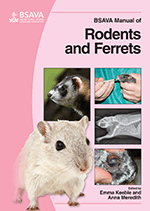
Full text loading...

The anatomy of the ferret eye is largely similar to that of other carnivores. However, the size of the ferret eye is proportionally and absolutely small, having an axial length of about 7mm. The conjunctiva lines the posterior face of the eyelids, the entire semilunar fold of the conjunctiva (third eyelid) and the exposed sclera before terminating at the corneal limbus (corneoscleral junction). Ferrets have a well developed third eyelid covered by tightly adherent conjuctiva on its bulbar and palpebral surfaces and it is usually either non-pigmented or pigmented at the margin. The third eyelid is reinforced by a T-shaped piece of cartilage that has a gland at its base that is responsible for secreting part of the aqueous layer of the tear film. There is no deep gland of the third eyelid. This chapter discusses Anatomy; Restraint and ophthalmic examination; and Ophthalmic diseases.
Ferrets: ophthalmology, Page 1 of 1
< Previous page | Next page > /docserver/preview/fulltext/10.22233/9781905319565/9781905319565.29-1.gif

Full text loading...








